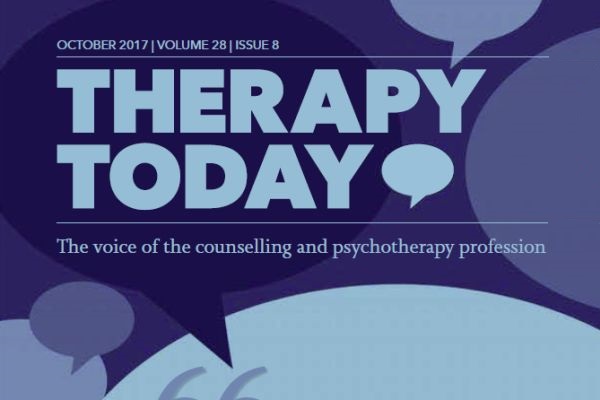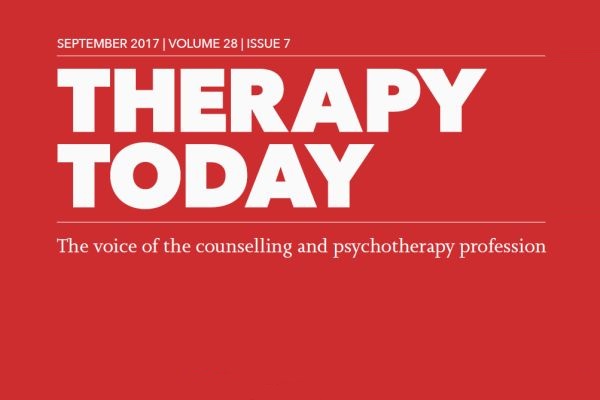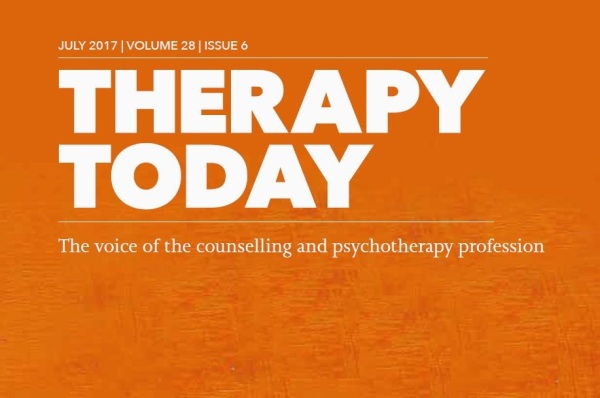Emma,* a London-based counsellor in private practice, realised all was not well when she found herself unable to make decisions. ‘Even small, inconsequential decisions, like what to do at the weekend, began to feel overwhelming,’ she says. Qualified for just six months, she decided to ‘dip her toe’ into private practice. ‘People said it would take time for my caseload to grow, which suited me,’ she says. But, within weeks she had 16 clients and was feeling overwhelmed.
‘People would say, “You’re doing great!” But it didn’t feel great. It felt too much. I wish I’d been told to approach it like running a marathon – you need to build up to a large caseload, rather than aiming to get a full caseload straight away, because it is totally different to any other job in terms of the emotional and physical demands.’
Emma had what she calls a ‘mini-breakdown’, where she withdrew from her social life and felt increasingly anxious and fearful. She came close to giving up, but, after a planned holiday, put some changes in place, including reducing her client load and changing her working hours, which made it possible to carry on. ‘It’s not easy, as it’s my sole source of income, but I realised that the number of clients I take on can’t be determined by finances,’ she says.
We may be mental health professionals, but counsellors don’t always ‘walk the talk’, and it’s all too easy to focus on improving our clients’ self-care and neglect our own. Even with an awareness of compassion fatigue and the impact of vicarious trauma, we can think ‘it won’t happen to me’. ‘Counsellors find it hard to admit when they are struggling. It’s similar to what I see in first responders and medical staff – there can be a shared culture of being strong, here to help others,’ says Fiona Dunkley, BACP senior accredited counsellor and trauma specialist. ‘We sacrifice our self-care for the greater cause.’
We can also fall into the trap of thinking that, because the lives of our clients are so awful, our needs pale by comparison, says Lisa Jenner, a BACP accredited counsellor and supervisor, who also delivers training on preventing vicarious trauma. ‘We can be blind to the impact on ourselves until it’s almost too late. It’s often friends and family members who recognise that we are struggling before we do.’
Nor is it necessarily about size of caseload; a manageable caseload can be tipped over into unbearable by just one client presenting with particularly acute or distressing needs.
Jenner herself didn’t realise that what she dismissed as ‘tiredness’ and the effects of juggling full-time work and family life were the warning signs of burnout. ‘People started to bring my attention to my memory and concentration problems. I was still able to be very present for my clients, but, outside the counselling room, I couldn’t follow a conversation. It was disorientating, and I got very irritable with my family and people close to me. Then, when I was driving, I would suddenly forget which pedal did what. I saw my GP and ended up in an MRI scanner and being tested for Alzheimer’s. Then, when everything was ruled out, it became clear I was suffering from stress and burnout.’
What is burnout?
Burnout is a ‘syndrome of emotional exhaustion, depersonalisation and reduced personal accomplishment that can occur among individuals who do “people-work”,’ explains Professor Christina Maslach, the US psychologist widely known for her pioneering research in this field and co-creator of the Maslach Burnout Inventory.1 She first came across it in the late 1970s, when she was an assistant professor at the University of California, Berkeley, and researching how people in the emergency services, hospitals and psychiatric units responded to challenges at work. ‘I stumbled across it in the interviews I was doing. A pattern emerged – people talked about feeling overwhelmed, emotionally and physically exhausted, and losing their sense of compassion. But when I first wrote an article about it, it was for a magazine, not a journal, because no journal was interested in it. They dismissed it as “pop psychology”. But that article got sacks of mail from people saying, “this is happening to me.” A lot of people had been struggling on, thinking it was just them, and they couldn’t let anyone know. If everyone else seems outwardly confident and competent, we look around and think, “I have to put on my happy face and not let anyone know I’m not doing as well.” But once we become more open to talking to each other, we realise we aren’t the only one feeling this way.’
What differentiates burnout from exhaustion, depression or anxiety, is often the most devastating symptom for therapists – compassion fatigue: the loss of a sense of caring about clients, or feeling irritated by their problems. ‘There can be shame in admitting that we are experiencing compassion fatigue, but we are humans, and we are not protected from stress just because we have therapeutic skills,’ says Dr Linda Dubrow-Marshall, BACP-accredited counsellor and lecturer in psychology at the University of Salford. ‘Admitting this means we can address these issues.’
Another insidious and undermining symptom is a sense of hopelessness about the efficacy of our work, says Professor Thomas Skovholt, educational psychologist at the University of Minnesota and author of The Resilient Practitioner.2 ‘We can feel less intensity in offering hope for the demoralised client, and a loss of a sense of the work being meaningful.’
Other symptoms vary from individual to individual. I know I am becoming emotionally ‘knocked off balance’ by a client’s material when I lose tolerance for any other ‘drama’ outside the counselling room, including plot lines in TV programmes and films. ‘When you have absorbed an amount of trauma vicariously, you can find that you no longer have the capacity to absorb it in entertainment,’ says Dunkley. ‘I am very mindful of what I expose myself to in social media and TV. I am exposed to enough trauma in my work, so I have to watch what I absorb in my personal life. Trauma is very related to adrenaline, so you can become overloaded.’
For others, burnout shows up in the body – we find ourselves more prone to bugs and viruses, or physical symptoms. ‘We need to listen to our body as it holds a wealth of information,’ says Dunkley. ‘We might be telling ourselves to keep going, but our body will be telling us to slow down by creating physical symptoms, aches and pains or illness.’
The toxic environment
But there is a danger in being too prescriptive about ‘typical’ symptoms of burnout, and therefore medicalising the condition, believes Maslach. ‘That was never the aim of my research. What worries me about making it into a “mental illness” is that it is essentially saying something about the individual – that they have a disease, they have a problem, so we have to fix the person. We should also be thinking about what is going on in the work environment. Burnout is a regular, chronic, everyday experience at work that wears you away, so that you can’t deal with stressors as you would normally.’
Maslach’s research has identified six factors that make burnout more likely: work overload, lack of control, insufficient rewards, breakdown of workplace community, absence of fairness, and value conflict.1
Organisational conflict is another risk factor, says Skovholt. ‘Internal conflict, especially among senior management, increases the risk of burnout. I have come across this even in senior therapists – we are supposed to be experts on human development, and these people are fighting and hating each other. That can be really distressing for the counsellors they are managing and supervising. It’s also hard when your values don’t match those of the organisation you are working for. Anything that takes away the meaning of the work or the sense of fairness or justness increases the risk of burnout.’
For Helen,* it was a sense of not being valued that undermined her wellbeing when she was working as a counsellor for a national charity. ‘It seems crazy now I look back on it, given that the charity was national and high profile, but I didn’t feel supported or that the work I was doing was valued. As an organisation, there was an awareness of vicarious trauma, but nothing was put in place to prevent it. I didn’t have enough supervision and, as I worked out in the field, I felt isolated from my colleagues. I also wasn’t paid very much, and that made me feel unappreciated. But it was my first job after qualifying, and I felt lucky to get it, so I didn’t question the conditions. By the time I felt confident enough to think it wasn’t right, the environment had undermined my resilience and I was finding it increasingly hard to deal with clients’ material. I had nightmares about my clients, became exhausted, and stopped eating and sleeping properly. All I wanted to do outside of work was zone out in front of the TV. In the end, I felt I had no choice but to leave.’
Skovholt has also explored this, with his colleague, Michael Helge Ronnestad, in their book, The Developing Practitioner.3 They describe how newly qualified practitioners in relationship-intense professions can easily become overwhelmed by the emotional demands of the work, especially in the early weeks and months, and can be driven to take an ‘early exit’, although most adjust and continue in their career.
Grief and uncertainty
Aspects of the work itself can also put the counsellor at risk – notably, according to Skovholt, the ‘accumulation of unresolved grief’. ‘A therapist–client relationship is a human relationship. As therapists, we are always being left by our clients,’ he says. ‘We have to let go of them, but what do we do then? Do we think about them? And we also have to keep up the capacity for new clients. We have to keep making attachments but we are always losing them.’
Another key factor is feeling you are not making a difference with clients. ‘Burnout is related to unclear, disappointing outcomes. It’s hard to sustain work where the results aren’t concrete,’ he says. Dr Els van Ooijen, supervisor, trauma specialist, and writer, agrees that it’s important to monitor your sense of ‘doing a good job’. She says: ‘Working outside of your experience and capability is extremely undermining. But, in organisations, counsellors can be in a situation where this feels unavoidable.’
There is also the ever-present element of anxious uncertainty from not knowing what work with a new client will involve. It can be particularly difficult if we have personal issues that are causing us distress when clients present with similar issues, says Dubrow-Marshall. ‘When my father died, I did not want to take on new clients who were coming to work on grief issues. Some family members were also demanding of me during that time, so I took a short break from working with very demanding clients, which allowed me to recover and heal. I also undertook personal therapy, and got outside input when I was ready to return to a more demanding and challenging practice.’
Protection and prevention
Babette Rothschild, in Help for the Helper,4 suggests varying the intensity of empathy in sessions as a protective measure. Skovholt says counsellors should aim simply to be a ‘good-enough counsellor’, and know when a B+ effort is enough for a client, rather than A+. He says that experienced counsellors often operate with ‘boundaried generosity’. ‘Being an effective therapist requires boundaries, but also generosity and willingness to give only so much,’ he says. ‘It’s like the advice about oxygen masks on an airplane – you have to put on your own before you can help anyone else.’
Maslach talks about the ‘detached concern’ used by medical professionals as a burnout defence. Of course, detachment is more difficult for therapists, for whom ‘putting ourselves into our clients’ shoes’ is core to our work. ‘You can work with “one foot in, one foot out”, rather than both feet in,’ says Dunkley. ‘With both feet in, you are too meshed with the client, and may not be the most effective in helping them.’
But it’s not easy. ‘I have experimented with Rothschild’s “varying the intensity” with clients and it just isn’t possible for me,’ says Jenner. ‘I can’t focus on the client and also hold something back for my own self-care. In the past, I have got over-involved; I’ve followed clients’ court cases to the point where I felt like I was also going through it with the client. I no longer do that. But I’ve realised I can’t control my level of empathy, so my self-care needs to focus on what I do after sessions.’
‘Care for self’ is one of six core principles that underpin our work as counsellors; ‘resilience’ is one of the ‘personal moral qualities’ we are advised to aspire to, defined as ‘the capacity to work with the client’s concerns without being personally diminished’ in the BACP Ethical Framework. As Professor Tim Bond, author of the framework points out: ‘Taking care of ourselves as practitioners matters to our clients. They need to know that we are sufficiently resilient to be able to work with them and to be able to withstand the challenges of that work.’
Effective supervision plays a key part, says van Ooijen. ‘Supervisors need to get to know their supervisee well enough so that they can tell when they are not themselves. I spend some time with supervisees at the start of the session checking that they are OK. You need to develop a working relationship so they feel they can discuss honestly with you what is going on.’
Independent supervision can be particularly important for those working in an organisation, she believes. ‘An independent supervisor is there as a check that your supervisee is not put into a position where they are working outside their level of experience and competence. That is where the Ethical Framework is helpful. I would advise counsellors to keep a copy with them at work and draw their employer’s attention to it when necessary. We also need to encourage counsellors to do appropriate CPD, particularly in areas where they feel under-confident. It helps them have confidence in themselves by developing their own reflective and critical thinking skills.’
After taking a four-month sabbatical, Jenner made changes to reduce the risk of burnout in the future, including reducing her counselling days. ‘My sabbatical reaffirmed that I loved being a counsellor, and I wanted to remain a counsellor, but doing it full-time wasn’t sustainable for me in the long term,’ she says. ‘I now see clients on two days a week, and focus on training and writing on the others, which affect me in a different way.’
Multiple roles can give a sense of perspective, agrees Skovholt. ‘Over the years I have thrived on doing teaching, supervision, therapy, research, and writing. But it doesn’t work for everyone – for some, it just adds to their sense of being overwhelmed.’
We also need to give some thought to what we do in our leisure time, he believes. ‘In my research, one of the things that has helped protect people from burnout is an element of “vitality” in their lives – having something in their personal life that really gives them a sense of pleasure, energy and high satisfaction. We are dealing with distressing, difficult things a lot of the time, so we need a contrast to that in our life, and for that to be ongoing. For one practitioner I talked to, it was absorbing herself in weaving.’
Dunkley recommends using a ‘ritual’ to ground yourself after a difficult session. ‘You need to find a way to symbolically shake off the energy that you have taken into your body. Sometimes I mindfully wash my hands, or do a simple breathing exercise, or some yoga moves. Another therapist I know uses juggling balls. If you don’t get rid of the energy, you risk bringing it into the next session, and then taking it home with you at the end of the day, which can spill into your personal life.’
Skovholt similarly sees value in rituals. He says he sometimes gets home from seeing several clients in a row in a state of what he calls ‘emotional depletion’, unable to think, listen or talk. ‘It’s a danger for the counsellor’s personal and family life. Rituals can help with the transition from counselling work to personal life.’
For Jenner, a key change was scheduling longer gaps between client sessions. ‘I make sure I do something physical in the break, such as stretching, or walking outside. It’s such a simple change but it makes significant difference.’ Dubrow-Marshall also suggests paying attention to the scheduling of clients: ‘I used to keep Monday mornings free for my most demanding clients – usually the least personally motivated to change or the most disturbed or narcissistic ones – as I had more energy after the weekend. I sometimes saw these clients one after the other, because I got into the therapeutic space I needed to be in order to work effectively with them.’
The most protective factor of all, says Maslach, from her four decades of research, is something that counsellors tend to be good at: human relationships. ‘Research about work and psychology for decades has shown that we are better able as human beings to live life, do well and cope, and be generally healthy if we have good relationships with other people. The more people we have who are fun to be with, teach us, and support us, the better off we are. It’s about keeping yourself grounded in the everyday and knowing you have people around who have your back.’
*Some contributors preferred to be anonymous.
Sally Brown is a counsellor and coach in private practice (therapythatworks.co.uk), a freelance journalist, and Executive Specialist for Communication for BACP Coaching.
More from Therapy Today

Ten reasons to feel good about being a counsellor today
Free article: At a time when we are dealing with cuts to both counselling services and training in universities, we can easily lose sight of how far we have come. Sally Brown offers 10 reasons to feel proud to be a counsellor today. Therapy Today, October 2017

What the doctor ordered
Free article: More and more people are taking prescribed antidepressant medication. But are the drugs helping or hindering? Sally Brown reports on the overlooked problem of prescribed-drug dependency. Therapy Today, September 2017

Not so, NICE!
Free article: NICE may again be questioning the effectiveness of counselling. Catherine Jackson reports. Therapy Today, July 2017
References
1. Maslach C. The cost of caring. Los Altos: Major Books; 2015.
2. Skovholt TM. The resilient practitioner: burnout prevention and self-care strategies for counselors, therapists, teachers, and health professionals (3rd ed). New York/London: Routledge; 2016.
3. Ronnestad MH, Skovholt TM. The Developing Practitioner. New York/London: Routledge; 2012.
4. Rothschild B. Help for the helper: the psychophysiology of compassion fatigue and vicarious trauma. New York: WW Norton & Co; 2006
